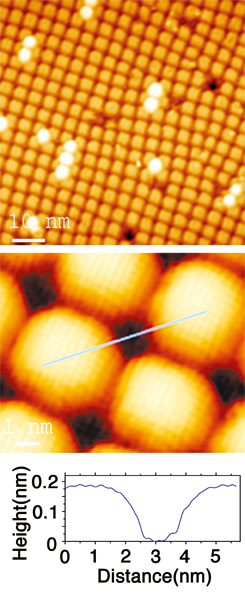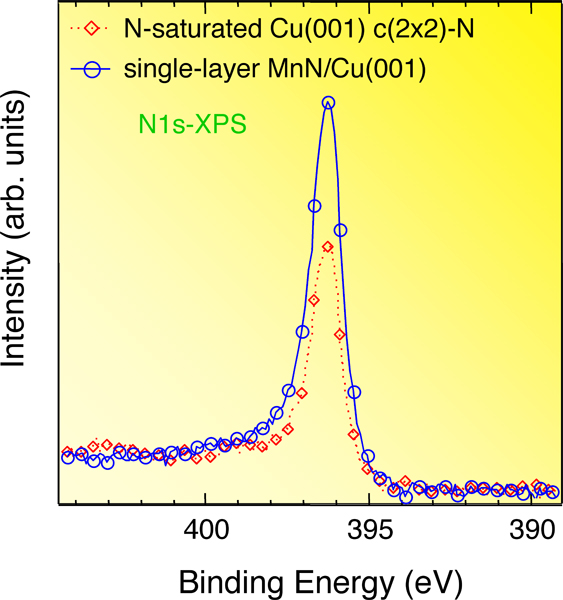Self-assembled MnN Superstructure
X. Liu, B. Lu, T. Iimori, K. Nakatsuji and F. Komori
Self-assembled nanostructures at surfaces have attracted tremendous interest in nanoscience. Among them, the ones with regular spatial array, uniform and well-defined geometric and structural characters, are especially desirable. However, it is still a challenge to prepare such high-quality nanostructures. Recently, we have fabricated self-assembled manganese nitride nano-islands on the Cu(001) surface and proposed a new mechanism of the self-assembly. [1]
As shown in Fig. 1, each island shows a square shape and has a well-defined size of 3 nm x 3 nm. They are regularly arranged with a periodicity of 3.5 nm and form a two-dimensional square superstructure. The depth of the trench between the islands is the same as the step height of the surface or the height of the island on the superstructure. The nano-islands adopt a 1 x 1 structure which is oriented in the same way as the fcc Cu(001) substrate. They are reproducibly prepared in three steps in ultrahigh vacuum by Mn deposition, atomic nitrogen exposure and annealing, and stable up to 820 K.
The stoichiometry of the manganese nitride islands is manganese mononitride as determined by in-situ x-ray photoemission spectroscopy [2] in Fig.2. The MnN film covers the whole surface, and is just mono-atomic-layer thick. The bulk MnN crystal has a distorted NaCl structure with a lattice constant 14 % lager than that of the Cu(001) surface [3]. Thus, the nanostructure formation is attributed to strain-relief at the interface. However, different from the conventional stress-domain dominated self-assembly, the shape, size, and periodicity of the MnN islands do not change even when they coexist with the clean Cu(001) surface. This indicates that the self-assembling is driven by a short-range mechanism. The presence of the MnN strips surrounding the MnN island can minimize the strain energy. We propose that MnN island is stabilized by such a simultaneous bilayer organization.

Fig.1 (a) Large-scale STM image of the self-assembled MnN nanoislands on a wide terrace. Square shaped islands of 3 nm x 3 nm form a two-dimensional square superstructure. (b) High-resolution STM image. Cross section profile along the blue line is presented in (c). Mn atoms are imaged on the surface, and the island is single atomic-layer high.

Fig.2 N-1s core-level spectra from a N-saturated Cu(001)c(2x2)-N surface and a single-layer manganese nitride covered surface. The coverage of nitrogen on the former surface is 0.5 mono atomic layer (ML). Thus the nitrogen coverage of the latter surface is 0.9 ML.
References
1. X. Liu, B. Lu, T. Iimori, K. Nakatsuji and F. Komori, Phys. Rev. Lett. 98 066103 (2007).
2. B. Lu, X. Liu, K. Nakatsuji,T. Iimori and F. Komori, Phys. Rev. B 98 245433 (2007).
3. K. Suzuki, T. Keneko, H. Yoshida, Y. Obi, H. Fujimori, and H. Morita, J. Alloys Comp.306 66 (2000).